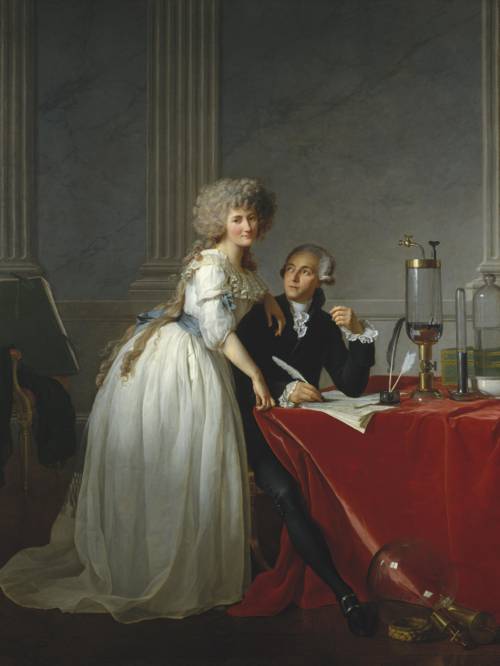
FAQ About Marie-Anne Paulze Lavoisier

Who was Marie-Anne Paulze Lavoisier?
Marie-Anne Paulze Lavoisier was a French chemist born in 1758. She is best known for her collaboration with her husband, Antoine Lavoisier, who is often regarded as the 'father of modern chemistry.' Marie-Anne played a crucial role in the chemical revolution of the 18th century by conducting important experiments, translating scientific works, and illustrating scientific publications.

What were Marie-Anne Paulze Lavoisier's contributions to chemistry?
Marie-Anne Paulze Lavoisier contributed significantly to chemistry through her collaboration with her husband. She translated scientific documents from English and Latin into French, making pivotal studies accessible to French scientists. She also illustrated many of Antoine's publications, helping to visually clarify chemical processes and experiments. Additionally, she conducted experimental work alongside her husband, assisting in the development of the law of conservation of mass.

How did Marie-Anne Paulze Lavoisier support Antoine Lavoisier's work?
Marie-Anne Paulze Lavoisier supported Antoine in many ways: she faithfully translated and edited manuscripts, illustrating complex chemical apparatus and procedures to make the ideas more understandable. Her translations included works by notable scientists such as Joseph Priestley and Henry Cavendish. Her involvement ensured that Antoine's groundbreaking ideas were communicated effectively to the scientific community.

What languages did Marie-Anne Paulze Lavoisier translate?
Marie-Anne Paulze Lavoisier translated texts from English and Latin into French. Her translations helped disseminate scientific ideas and findings across linguistic boundaries, fostering greater international collaboration and understanding in the field of chemistry during her time.

What is Marie-Anne Paulze Lavoisier's legacy in the field of chemistry?
Marie-Anne Paulze Lavoisier’s legacy in chemistry includes pioneering collaborative work that was fundamental to the scientific revolution in chemistry. Her contributions to translating, illustrating, and conducting experiments alongside Antoine helped lay the groundwork for modern chemical practices and concepts. She is remembered as one of the earliest women to impact the field significantly, inspiring future generations of female scientists.

Did Marie-Anne Paulze Lavoisier speak multiple languages?
Yes, Marie-Anne Paulze Lavoisier was multilingual. She notably translated scientific documents and papers from English and Latin into French, thereby playing a critical role in the spread of scientific knowledge across Europe during the 18th century.

What was Marie-Anne Paulze Lavoisier's role in the Chemical Revolution?
During the Chemical Revolution, Marie-Anne Paulze Lavoisier was instrumental in both the scientific and communicative breakthroughs achieved by her husband, Antoine Lavoisier. She conducted experiments, provided clear diagrams in scientific publications, and translated pivotal works that helped shift scientific paradigms from alchemical traditions to those based on modern chemistry.

How did Marie-Anne Paulze meet Antoine Lavoisier?
Marie-Anne Paulze met Antoine Lavoisier when she was 13 years old. She was married to him at the age of 14, under arrangements orchestrated by her father who was an administrator with the Ferme Générale, a large firm involved in tax collection, for which Antoine worked. Their marriage allowed Marie-Anne to become deeply involved in her husband’s scientific work.

Did Marie-Anne Paulze Lavoisier work independently of her husband?
Most of Marie-Anne's recognized work was done in collaboration with her husband, Antoine Lavoisier. While they worked closely together, her contributions, especially in translation and illustration, were independently significant to the scientific community. Her ability to communicate and document complex scientific concepts was crucial for the advancement of their work.

What notable translations did Marie-Anne Paulze Lavoisier perform?
Marie-Anne Paulze Lavoisier is well known for translating Richard Kirwan’s "Essay on Phlogiston," a pivotal work in the rejection of the phlogiston theory, and other key scientific texts by Joseph Priestley and Henry Cavendish. Her translations played a crucial role in shaping the modern field of chemistry by providing critical access to new scientific ideas and discoveries.

What was the impact of Marie-Anne Paulze Lavoisier's translations?
The translations by Marie-Anne Paulze Lavoisier had significant impacts, as they made groundbreaking chemical concepts accessible to French-speaking scientists. Her work facilitated international scientific communication and collaboration and was instrumental in the acceptance of Antoine Lavoisier's new chemical theories, which were foundational to modern chemistry.

Did Marie-Anne Paulze Lavoisier contribute to any scientific publications?
Yes, Marie-Anne Paulze Lavoisier contributed significantly to several scientific publications prepared by her husband, drawing detailed and informative illustrations of experiments and chemical apparatus. Her work ensured that these scientific principles and processes were better understood by readers, facilitating the spread of new ideas within the scientific community.

How is Marie-Anne Paulze Lavoisier remembered today?
Marie-Anne Paulze Lavoisier is remembered as a pioneering woman in science whose efforts in translation, illustration, and experimentation paved the way for modern chemical science. Her role as a vital collaborator with Antoine Lavoisier highlights her as a key figure in the Chemical Revolution. She stands as both an inspiration and a testament to women's early contributions to science.

What role did illustrations play in Marie-Anne Paulze Lavoisier's work?
Illustrations played a crucial role in Marie-Anne Paulze Lavoisier's contributions to chemistry. Her detailed drawings of chemical apparatus and experiments helped clarify complex subjects, making abstract scientific concepts more comprehensible to others. Her visual documentation was essential in educating readers and advancing the field during a transformative period in chemistry.

Was Marie-Anne Paulze Lavoisier formally trained in chemistry?
Marie-Anne Paulze Lavoisier was not formally trained in chemistry through traditional educational institutions. However, she educated herself through her partnership with her husband, observing, assisting, and learning actively as she engaged in their scientific works. Her keen intellect and observation skills allowed her to make meaningful contributions to their research.

Did Marie-Anne Paulze Lavoisier publish any works under her own name?
No, Marie-Anne Paulze Lavoisier did not publish works under her own name. Most of her scholarly contributions were attributed to collaborative works with her husband, Antoine Lavoisier. Despite this, her impact was significant, and contemporary recognition has sought to highlight her contributions and accomplishments in their joint efforts.

How did Marie-Anne Paulze Lavoisier contribute to the law of conservation of mass?
Marie-Anne Paulze Lavoisier contributed to the research leading to the law of conservation of mass through her collaboration with Antoine Lavoisier. She assisted in performing experiments and documenting results, which were critical in formulating this law. Her systematic and careful approach to experimental documentation aided in the successful demonstration and communication of this fundamental principle in chemistry.

What was Marie-Anne Paulze Lavoisier's educational background?
Marie-Anne Paulze Lavoisier did not have a formal education in science, which was typical for women of her time. Her involvement in scientific pursuits began with her marriage to Antoine Lavoisier. She received an informal education through active participation in scientific experimentation and engagement with the scientific community in Paris, where she honed her skills and knowledge.

How did Marie-Anne Paulze Lavoisier influence women's role in science?
Marie-Anne Paulze Lavoisier's work demonstrated that women could contribute significantly to scientific discovery and discourse. Her involvement and success in a male-dominated field provided inspiration and a pathway for future generations of women in science. Her legacy continues to inspire women to pursue careers in STEM fields, highlighting the valuable perspectives and insights they bring to scientific endeavors.

What were some of the challenges Marie-Anne Paulze Lavoisier faced in her scientific career?
Marie-Anne Paulze Lavoisier faced the challenge of working within a male-dominated field where women's contributions were often undervalued or unacknowledged. Despite these societal constraints, she managed to leave a lasting impact through her work in translation, illustration, and experimentation. Her ability to collaborate closely with influential scientists of the time helped overcome some barriers, yet she rarely received public recognition during her lifetime.
